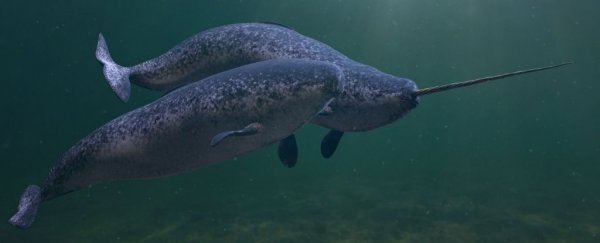From the outside, the narwhal's unicorn-like tusk is a striking curiosity. On the inside, this long protruding tooth contains an entire life history of the marine mammal's migration and meals, from its first breath to its last.
Peeling back each of these growth layers, researchers have now read the rings of 10 narwhal tusks from northwest Greenland.
"It is unique that a single animal in this way can contribute with a 50-year long-term series of data," says marine mammal researcher Rune Dietz from Aarhus University, Denmark.
Consistent data over half a century is very rare and provides an invaluable glimpse at how this particular species of toothed whale is coping under rapidly changing conditions.
Today, scientists know very little about narwhals. Much of their lives are spent under huge slabs of ice in the remote Arctic. No one can even agree why narwhal tusks exist in the first place – yet exist they do, sometimes growing up to 3 meters (9.8 feet) in length.
As males (and a few females) age, their upper left canine begins to extend outwards in a spiral, ultimately piercing their upper lip. Some experts think males use this elongated tooth to impress females or to mark their territory, at times crossing 'swords' with another.
Footage from a few years ago reveals these pointy teeth are also used to hunt fish by hitting and stunning them. The sensitive tooth can even be used as a 'bio sonar', allowing the species to navigate the darker depths of the ocean.
Today, with climate change, the Arctic is warming much faster than the rest of the world, and narwhals are considered the region's most vulnerable marine mammals, and, it turns out, historically valuable.
Analyzing the chemical content in every layer of the narwhal tusk, researchers created lifetime profiles for each individual's feeding and mercury exposure up to 2010. Carbon and nitrogen isotopes in these teeth were specifically used to reveal where each individual fed and what they were eating, with some samples dating as far back as 1962.
"Here, the data is a mirror of the development in the Arctic," Dietz says.
Until the 1990s, narwhals in this region of the Arctic appeared to be eating fish like halibut and Arctic cod, both of which rely heavily on sea ice.
Yet at the same time that Arctic ice began to rapidly melt, this group of narwhals shifted their appetite, chowing down on open-ocean fish like capelin and polar cod. It's still unclear what drove this transition, but the authors say climate change is the most likely culprit.
Since the turn of the century, the amount of mercury in narwhal tusks has increased significantly, researchers say, possibly from changes in the whale's diet or an increase in human pollution from activities like mining, coal power production, cement production, or waste incineration.
While it's generally good news that these narwhals are somewhat flexible with their migration and diets, especially in response to sea-ice melt, their mercury levels do not look nearly as promising.
How toxic all that mercury actually is for the mammal is still unclear, but the trend matches other animals in the region, which have also shown higher mercury levels in recent years.
"What we found in narwhals of Northwest Greenland is consistent with a more general trend across the Arctic where sea ice is declining and changing the spatial distribution of sub-Arctic and Arctic fish as well as top predators," says ecotoxicologist Jean-Pierre Desforges from McGill University, Canada.
"The big question now is how these changes will affect the health and fitness of key Arctic species in the years to come."
Unfortunately, narwhals are not great at eliminating contaminants like mercury, which makes them especially vulnerable to these changes.
"They don't get rid of mercury by forming hair and feathers like polar bears, seals, and seabirds, just as their enzyme system is less efficient at breaking down organic pollutants," explains Dietz.
The authors think the unexpected and rapid rise in narwhal mercury is either due to more human pollution, a shift in the region's food web, or a bit of both.
Narwhals might be feeding on prey lower in the food chain, for instance, and these animals tend to hold more accumulated mercury.
"The higher you are in the food chain, the more mercury you accumulate into your body throughout your life," explains Desforges.
Other top predators in the region, like the Arctic fox and polar bears, also have greater mercury in their soft tissue when there is less sea ice around, which supports the idea that climate change has something to do with it.
Researchers are now hoping to use older narwhal tusks from the archives of museums to figure out how these mammals have been coping with mercury and climate change over even longer spans of time.
The study was published in Current Biology.
